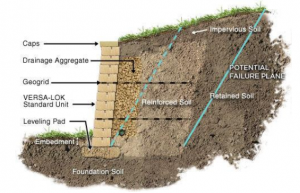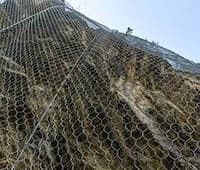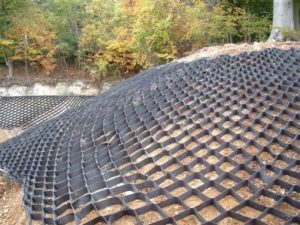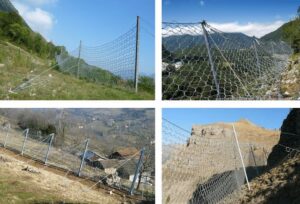When to use Geogrid in retaining wall?

You’ve undoubtedly seen a few retaining walls knocked over or leaning fairly hard in the wrong way if you’ve spent any time travelling around the Fox Cities. I noticed this magnificent snap-faced limestone wall had a lean years ago when passing by it for the first time on a client visit on Bell St in Neenah (I won’t specify which one, but it’s near highway 41).
I got out of my vehicle, snapped a few quick photos, and later that week, I sent a letter to the business expressing that I was concerned about their magnificent wall collapsing on them (a wall we hadn’t constructed), and that I could fix it so it didn’t.
Retaining walls collapse for one of only two or three causes. Inadequate drainage behind a wall is one of the most prevalent problems. This allows freeze-thaw cycles, such as those that will be a daily occurrence in Wisconsin in March and April (and again in October and November), to press on our clay-backfilled retaining walls by night, with the ice melting and moving deeper by day to push again the next night.
Another major reason why retaining walls in Wisconsin’s Fox River Valley collapse is that they are required to keep back more soil than they are capable of holding. Retaining walls built by well-intentioned do-it-yourselfers and even landscaping contractors who should know better are doomed to fail. They’re being built higher than they can support without reinforcement, forcing clients in our area to spend tens of thousands of dollars (and one client I met was facing the prospect of having to RE-spend hundreds of thousands) to have these retaining walls torn down to the ground and rebuilt from the ground up. Still don’t trust us? Go ahead and look up retaining wall failures on Google and see what you come up with. The project depicted on the right is based in the Fox Cities. We did not construct it, and this graphic depicts only a fraction of the numerous, catastrophic failures. During our post-failure inspection, we discovered hardly no reinforcements.
The Reinforcement of a Retaining Wall
The process of reinforcing a segmental retaining wall is simple, and the materials necessary are inexpensive. It necessitates extra excavating, backfilling, and compaction, but the expense is little when compared to the cost of having a retaining wall built twice. (As an aside, many clients who are focused solely on the bottom line fail to ask about geogrid or whether it is required for their project, and instead choose a contractor who simply does not understand the mechanics of retaining walls or when geogrid is required, and the money they save today ends up costing them later.) We’re not just repeating the old adage that “you get what you pay for.” We’ve gone to a lot of meetings where a lawsuit is ongoing, and the potential client is trying to figure out how much to sue for in court since their prior landscaping contractor did a bad job.)
Geogrid is the name of the material utilised. There are a number different manufacturers and designs of geogrid, but all varieties are best characterised as a woven fabric with high tensile strength that is pinned between layers of retaining wall and extends back into the soils the wall is retaining to link the block or stone wall with the soils behind it. When geogrid is added to a retaining wall, the retained soils become helpers in the retention process, thereby making the retaining wall considerably more enormous than the weight of the block or stone alone.
When building new projects, it is becoming increasingly important to use conservative methods. This is to provide a high level of dependability and durability. Artificial slopes and geotextile/geogrid reinforcement slopes are frequently employed to keep barriers in place because they provide stability.
The use of woven geotextiles and geogrids to provide internal drainage for Geosynthetic reinforced soil (GRS) walls with poorly draining marginal backfill improves the internal stability of buildings.
Retaining walls may require soil reinforcement depending on the wall height and site circumstances. Geogrid or geotextile installation, to the best of our knowledge, can be utilised to strengthen soil behind retaining walls.
How to Use Geogrid and Geotextile Reinforcement to Retain Walls
As the demand for retaining walls grows, a variety of options are being considered. As a result, ground engineering continues to advance in its understanding of how to use these systems in novel ways.
For the construction of both green- and hard-faced retaining walls, there are several geotextile installations options.
Cross section of a retaining wall with reinforced soil
If the weight of the wall units alone is insufficient to resist the force of an unstable soil wedge or any load above it, geogrid soil reinforcement is used.
The reinforced soil mass is held together by horizontal layers of geogrid, which give tensile strength.
As a result, the geogrid-reinforced soil mass becomes a component of the retaining wall system, giving it with the additional size and weight it need to withstand forces from behind it. To support the strengthened soil mass inside, extra layers of stronger geogrids are inserted for taller walls.
Longer geogrid lengths are needed as the wall becomes taller to increase the amount of the geogrid-reinforced soil mass.
Soil reinforcement using VERSA-Grid
VERSA-Grid is a lightweight, versatile, and simple-to-install grid system. It’s available in a variety of strengths that are widely used for landscaping and commercial walls. Because VERSA-Grid has no memory, it lays flat when unrolled.
Some residential walls employ VERSA-Grid 1.5, but only for walls up to 6 feet height. It comes in rolls of 22 square yards each (4-ft. wide by 50-ft long rolls).
Cross section of a retaining wall made of unreinforced dirt
Unreinforced soil retaining walls keep potentially unstable wedges of soil at bay. The maximum stable unreinforced height is reduced by additional weight, bad soils, or slopes on top of or below a wall.
Unreinforced walls can be 3-4 feet tall in the ideal situations, depending on the type of unit utilised, soil type, and other site factors.
Typical Geotextile and Geogrid Reinforcement Applications
Geogrids come in a wide range of applications and finishes (hard facing, gabions, vegetated, etc.) to suit even the most discerning aesthetic needs. Take a look at the following apps:
- Retaining walls are a type of retaining wall that is used to keep
- Reinforcements for the slope
- Walls made with greenery
- Bunds and embankments that have been steepened
- Earthen structures with reinforcement
- Bunds that are becoming more brittle
- Slope stabilisation using veneer
The Most Important Advantages of Geotextile and Geogrid Reinforcement
- Land take is reduced.
- Walls that are environmentally friendly
- Solutions that are SuDS-compliant
- Walls that are higher
- Imports of materials are being reduced.
- Supply, design, installation, and maintenance from a single supplier
- Plantings made to order
Geogrid Soil Reinforcement Required for Wall Heights
For walls taller than 3-4 feet, most soil reinforcement kits require geogrid. Meanwhile, if there are poor soils, loads above the wall, steep slopes near the wall, or tiered walls, geogrid can be utilised to reinforce shorter walls.
It is recommended to adjust for “almost uncontrollable” impacts on the durability and stability of such buildings, regardless of wall heights (whether tall or short). For the safety and longevity of walls, certain requirements are necessary (whether tall or short).
Fortunately, as compared to the costs of traditional retaining walls, woven geotextile installation is a comparatively cheap cost for reinforced retaining walls.
In a nutshell,
Geogrid is a polymer-based geosynthetic material that is placed horizontally between wall courses and extends into the soil behind a wall.
Geotextile reinforcement is designed to improve the stability and bulk of a wall structure while also stabilising the soil.
Geotextile reinforced structures have a lengthy track record of performance. The geotextile wall construction technology is extensively utilised and largely approved for both low-profile and high-profile constructions in terms of safety and dependability.



